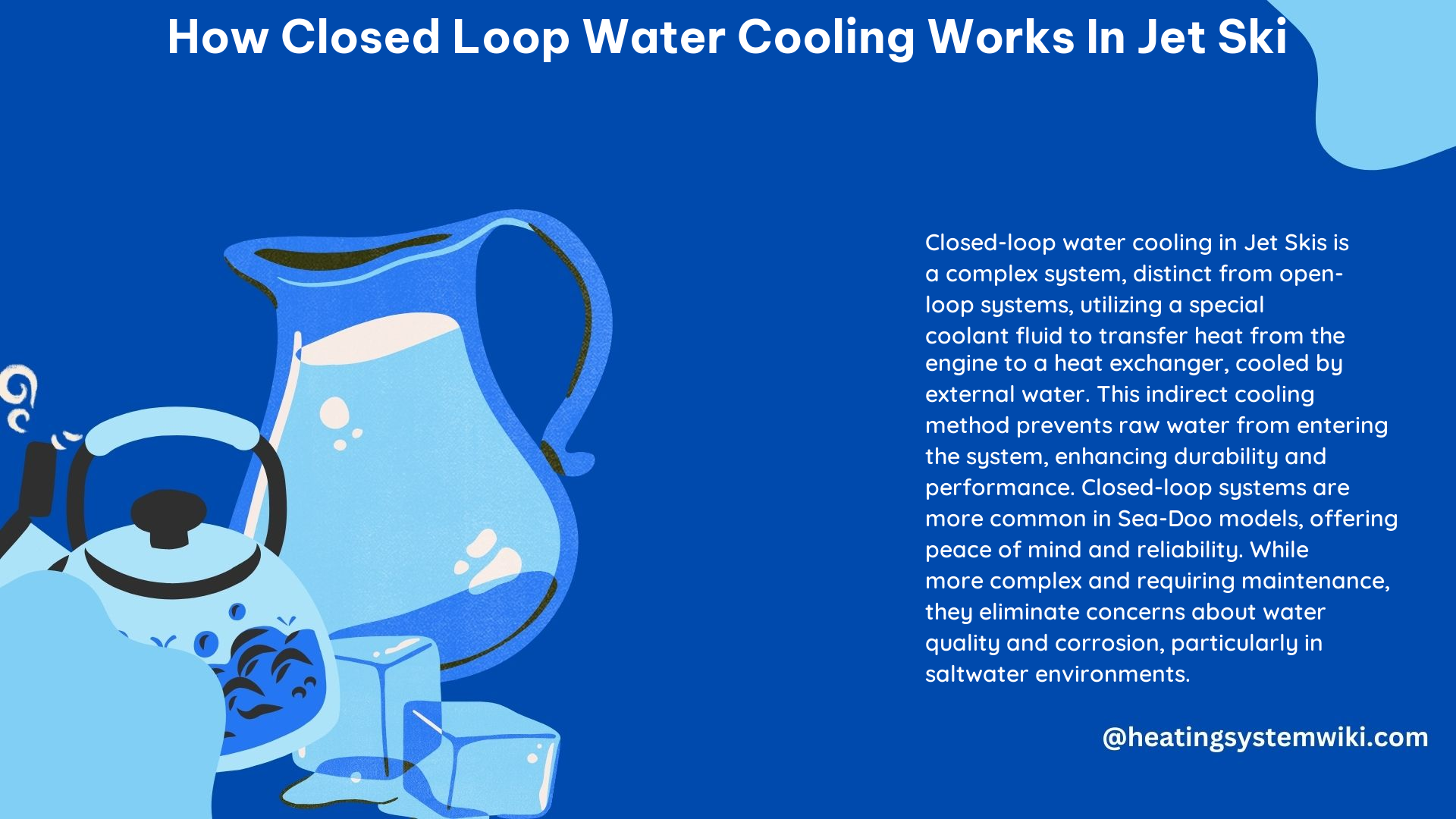A closed-loop water cooling system in a Jet Ski, also known as a liquid-cooled system, is a more complex and advanced cooling solution compared to an open-loop system. It utilizes a special coolant fluid, such as antifreeze, to efficiently transfer heat away from the engine, ensuring optimal performance and longevity.
Understanding the Closed-Loop Cooling System
In a closed-loop system, the coolant fluid is circulated through the engine, absorbing the heat generated during operation. The heated coolant then passes through a heat exchanger, where it is cooled by the external water. This process allows the engine to maintain a consistent operating temperature, preventing overheating and ensuring reliable performance.
Key Components of a Closed-Loop Cooling System
-
Coolant Pump: The heart of the closed-loop system, the coolant pump is responsible for continuously circulating the coolant fluid through the engine and heat exchanger. Typically, a 12V DC pump with a flow rate of 3-5 gallons per minute is used.
-
Heat Exchanger: The heat exchanger is a critical component that facilitates the transfer of heat from the coolant to the external water. It is typically made of aluminum or copper and has a surface area of 1-2 square feet.
-
Radiator: The radiator, often mounted at the rear of the Jet Ski, dissipates the heat absorbed by the coolant, allowing it to cool down before recirculating through the system. The radiator is usually made of aluminum or copper and has a surface area of 2-3 square feet.
-
Coolant Reservoir: The coolant reservoir, made of plastic or metal, stores the coolant fluid and maintains the proper level in the system. It typically has a capacity of 1-2 gallons.
-
Coolant Mixture: The coolant used in a closed-loop system is a 50/50 mixture of antifreeze and distilled water. This combination provides effective heat transfer, corrosion protection, and freeze protection for the engine.
Advantages of a Closed-Loop Cooling System
-
Engine Protection: The closed-loop system shields the engine from the corrosive elements found in seawater, such as salt and other contaminants. This is particularly beneficial for Jet Ski owners who frequently ride in ocean environments.
-
Consistent Temperature Control: By maintaining a consistent operating temperature, the closed-loop system ensures optimal engine performance and longevity, preventing overheating and thermal-related issues.
-
Improved Reliability: The closed-loop system’s ability to protect the engine from corrosive elements and maintain consistent temperatures contributes to the overall reliability and durability of the Jet Ski.
Converting from an Open-Loop to a Closed-Loop System

Converting an open-loop system to a closed-loop system involves the installation of several key components:
-
Heat Exchanger: The heat exchanger is installed in the cooling system to facilitate the transfer of heat from the coolant to the external water.
-
Radiator: The radiator is mounted, typically at the rear of the Jet Ski, to dissipate the heat absorbed by the coolant, allowing it to cool down and recirculate through the system.
-
Coolant Reservoir: The coolant reservoir is added to the system to store the coolant fluid and maintain the proper level in the closed-loop.
-
Coolant Pump: A dedicated coolant pump is installed to ensure the continuous circulation of the coolant fluid through the engine and heat exchanger.
It’s important to note that the exhaust system in a closed-loop system is not directly affected by the cooling system conversion. However, it is crucial to ensure that the exhaust system is properly sealed and functioning correctly to prevent any coolant leakage into the exhaust.
Technical Specifications and Considerations
When designing or upgrading a closed-loop water cooling system for a Jet Ski, the following technical specifications and considerations should be taken into account:
Coolant Pump:
– Voltage: 12V DC
– Flow Rate: 3-5 gallons per minute
Heat Exchanger:
– Material: Aluminum or Copper
– Surface Area: 1-2 square feet
Radiator:
– Material: Aluminum or Copper
– Surface Area: 2-3 square feet
Coolant Reservoir:
– Material: Plastic or Metal
– Capacity: 1-2 gallons
Coolant Mixture:
– Antifreeze to Distilled Water Ratio: 50/50
It’s essential to ensure that all components are properly sized and compatible with the specific Jet Ski model and engine configuration to achieve optimal cooling performance and reliability.
Conclusion
A closed-loop water cooling system in a Jet Ski offers several advantages over an open-loop system, including improved engine protection, consistent operating temperatures, and enhanced performance. While the conversion process may require some technical knowledge and expertise, the benefits of a closed-loop system make it a worthwhile investment for Jet Ski enthusiasts who frequently ride in various water conditions.
References:
– Open vs Closed Loop Cooling in Sea-Doo PWCs
– Sea-Doo Closed Loop vs Open Loop Cooling
– How Closed Loop Cooling Works
